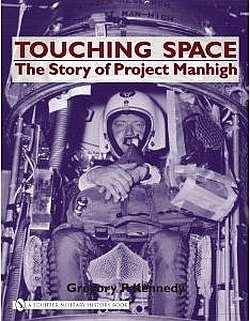Touching Space. The story of Project Manhigh (Book)

Touching Space. The story of Project Manhigh It's a book writen by Gregory P. Kennedy, aerospace historian and former Director at the Space Center in Alamogordo, New Mexico. It was released by Schiffer Publishing in 2007 in coincidence with the 50th anniversary of the MANHIGH project, a manned balloon program considered as an important steping stone of the man in the space.
Along the 128 pages of the book Kennedy makes a deep dive in the history of the program, but not only that: also he offers a contextual introduction to the manned exploration of the stratosphere. The book's first three chapters are devoted to the early aerial pioneers like Charles, De Rozier, Blanchard, Jeffries, Coxwell, Glaisher and the spanish Herrera, the discovery of the cosmic rays by Victor Hess, ending with the famous flights made by the Piccard twins in Europe and Northamerica and the two Explorer ascensions from the Stratobowl in the 30's.
Few people know that the origin of Manhigh can be traced back to 1947, when started the era of the plastic balloon. That's is the topic of the next two chapters, centered mainly in the projects of those years like "Gopher", the Navy "Skyhook" as well in the first balloon-borne cosmic ray studies using animals. This last research soon will lead to the next logical step to use instead animals a human pilot. So entering in the "core" of the book chapter 6 shows the development of the program and introduces the first test flight -known as Manhigh I- wich is covered in full length in chapter 7. Then continues logically with the second flight -really the first scientific one- covered in extreme detail on chapter 8 and the last one -Manhigh III- closing the program on the next.
Ending the book the author makes an in-deep analysis of the post-Manhigh projects and the reasons of the closing of the program. Three appendix add information on several related topics as well in others similar programs being run in parallel with the Air Force project.
As a result of the research done, Kennedy gives to its readers a book extremely well documented, plenty of human and technical details on the program not widely known. The reading is easy, being oriented to the general public, without technical complexities but at the same time explaining each topic deeply, helping to build in the lector a complete figure of the dimension of the task undertaken with the technology then available. As a final note we can say that the book goal to emphasize the human factor of the entire project is fully accomplished: it portrays perfectly the eagerness and decision of the man involved on the program, from pilots and managers to meteorologists risking careers and lives putting hardware and men under space conditions.

